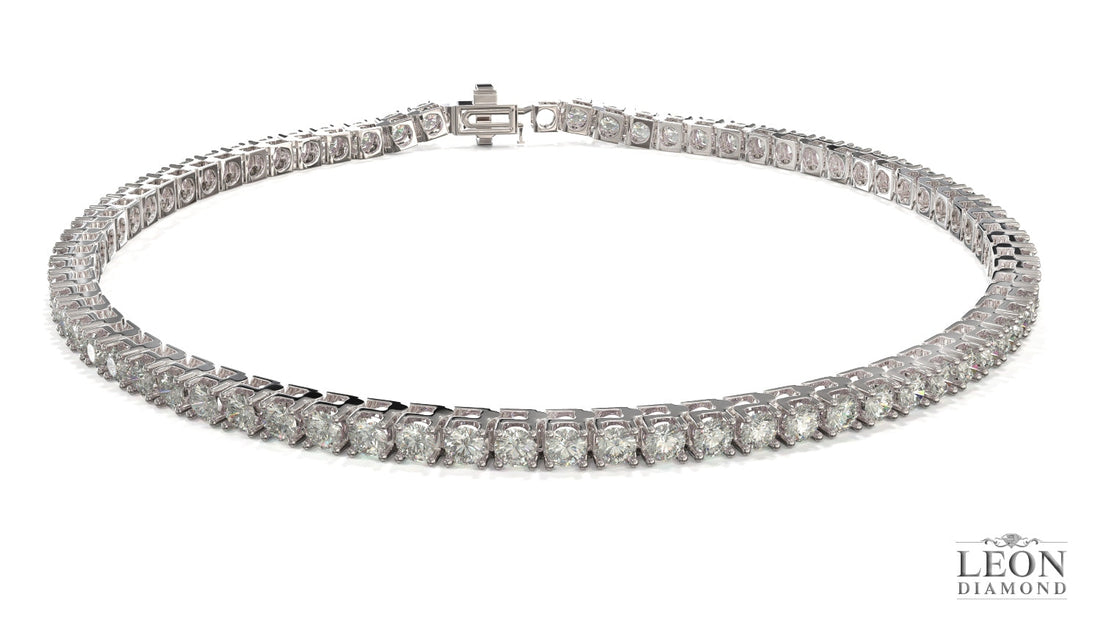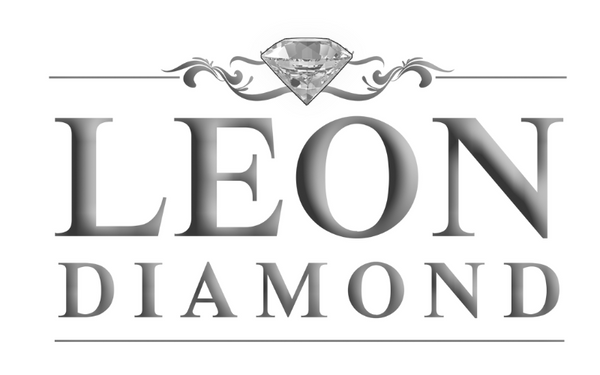
The Anatomy of a Tennis Bracelet: Prongs, Links & Clasps Explained
Share
A tennis bracelet is a timeless jewelry piece known for its continuous line of diamonds or gemstones that elegantly encircle the wrist. Its popularity surged in 1987 when tennis champion Chris Evert famously lost her diamond bracelet mid-match, halting play until it was found. Since then, the bracelet has been forever associated with elegance, luxury, and precision. Today, tennis bracelets remain celebrated for their sleek design, fine craftsmanship, and lasting appeal. According to the Gemological Institute of America (GIA), assessing stone quality and secure settings is essential when choosing one. In this blog, we'll break down its anatomy, prongs, links, clasps, gemstones, styles, buying tips, care, and mistakes to avoid..
Prongs: Protecting and Showcasing Gemstones
Prongs are the small yet crucial components that hold each stone securely while maximizing its brilliance.
What Are Prongs?
Prongs are small metal claws that hold each diamond or gemstone in place, allowing maximum light to pass through, enhancing brilliance and sparkle. They are often overlooked but are essential for both security and aesthetics. Without well-crafted prongs, stones may loosen, reducing durability and shine.
Types of Prong Settings
- Three-Prong Setting: Offers a minimalist look with more light exposure. Ideal for small to medium stones and modern bracelet designs.
- Four-Prong Setting: Provides maximum security and balance, preferred for larger stones and classic designs.
- V-Prong Setting: Protects the pointed corners of gemstones, commonly used for princess-cut diamonds.
Material Considerations
Prongs are made from metals like platinum, white gold, yellow gold, and rose gold. Platinum is highly durable and hypoallergenic, making it ideal for securing valuable stones. White gold complements diamonds' brilliance, while yellow gold provides a warm, classic aesthetic.
Common Prong Problems and Solutions
Over time, prongs can loosen due to wear or impact. Regular inspections at least twice a year and professional tightening prevent stone loss. Avoid harsh chemicals that weaken metal integrity, and consider prong thickness based on gemstone size for added durability (Frost NYC).
Links: The Backbone of a Tennis Bracelet

Links are the backbone of a tennis bracelet, connecting each gemstone seamlessly while ensuring flexibility, comfort, and durability.
Role of Links in Design and Flexibility
Links are the building blocks of a tennis bracelet. They connect stones and allow flexibility for comfortable wear. Links determine the bracelet's movement, durability, and how light interacts with each gemstone.
Types of Link Settings
- Prong-Set Links: Traditional style allowing maximum light exposure. Popular for classic diamond tennis bracelets.
- Bezel-Set Links: A protective metal rim encircles each stone, ideal for durability and a modern aesthetic.
- Channel-Set Links: Channel settings hold stones securely between metal walls, providing a sleek and continuous appearance often used in high-end jewellery.
How Link Style Influences Design
Prong-set links maximize sparkle and elegance, bezel-set links provide security and contemporary appeal, and channel-set links offer symmetry and robustness. Competitor brands like Grown Brilliance and Haus of Brilliance emphasise channel-set designs for modern luxury aesthetics.
Maintenance Tips
Inspect each link for loosened stones or metal fatigue. Use soft brushes and gentle cleaning solutions to maintain lustre. Avoid bending links to preserve structure and alignment.
Clasps: Reliable Closure for Timeless Wear
Clasps keep your tennis bracelet securely fastened while complementing its design and ensuring comfortable daily wear.
Importance of Clasps
A bracelet's clasp may seem minor, but it is critical for safety. A secure clasp prevents loss, maintains bracelet alignment, and complements overall design.
Types of Clasps
- Box Clasp: Reliable and sleek, often with a safety latch. Common in high-end tennis bracelets.
- Lobster Clasp: Easy to operate but may require professional adjustment for larger bracelets.
- Slide Clasp: Provides adjustable length, increasing comfort for various wrist sizes.
- Toggle Clasp: Toggle clasps are frequently utilized in designer jewelry for their aesthetic appeal and functionality. Their unique design allows them to serve as both a clasp and a decorative element, enhancing the overall look of the piece.
Selecting the Right Clasp
Consider wrist size, gemstone weight, and daily wear frequency. Box clasps provide maximum security, while slide clasps enhance flexibility. Check the clasp regularly for metal fatigue or loosened mechanisms.
Diamonds and Gemstones in Tennis Bracelets
The quality, cut, and clarity grades of diamonds and gemstones determine the brilliance, value, and overall elegance of a tennis bracelet.
Diamond Quality Factors
Understanding the 4Cs diamond: cut, clarity, color, and carat is essential:
- Cut: Determines light reflection and sparkle.
- Clarity: Fewer inclusions mean higher value.
- Color: Near-colorless diamonds are most sought-after.
- Carat Weight: GIA notes that diamonds weighing just over "magic sizes" such as 1.00, 1.50, or 2.00 carats can command significantly higher prices, even if the visual difference is minimal.
Gemstone Alternatives
Sapphires, rubies, and emeralds offer personalized color options. Lab-grown diamonds provide eco-friendly alternatives without sacrificing brilliance (International Gem Society).
Setting Techniques
Prong settings maximize brilliance; bezel and channel settings enhance durability. The choice of setting affects light exposure, security, and overall aesthetic.
Popular Tennis Bracelet Styles: Timeless and Modern Designs
From classic single-row diamond bracelets to bold multi-row creations, tennis bracelets offer styles that suit every taste and occasion.
Classic Designs
- Single-Row Bracelets: Timeless, elegant, and suitable for everyday wear.
- Multi-Row Bracelets: Dramatic and luxurious, often featuring larger stones.
Designer Variations
- Mixed Metals: Combine white, yellow, and rose gold for contrast.
- Custom Engravings: Add initials or special dates for a personalized touch.
Trend Insights
This trend report highlights how the fine diamond jewelry industry is embracing bold, statement designs. It emphasizes a movement toward maximalism, including the popularity of multi-row arrangements and mixed-metal finishes, commonly found in luxury bracelet lines.
Essential Buying Tips for Tennis Bracelets
Choosing a tennis bracelet goes beyond beauty; it requires attention to quality, comfort, and long-term value.
Key Considerations
- Stone Quality: Evaluate using the 4 Cs.
- Setting Integrity: Prongs and links must be secure.
- Clasp Security: Ensure durability and ease of use.
Authenticity Verification
- Certifications: Always request GIA, IGI, or equivalent documentation.
- Craftsmanship: Check smooth prongs, aligned stones, and uniform metal finish.
Pricing Insights
- Factors influencing cost: stone quality, metal type, craftsmanship, and brand reputation.
- Compare multiple jewelers for value and authenticity.
Preserving Elegance Through Proper Care

Proper maintenance not only protects your tennis bracelet's beauty but also safeguards your investment for years to come.
Daily Wear Precautions
- Avoid impact, harsh chemicals, and excessive water exposure.
- Remove bracelets during exercise or cleaning.
Cleaning and Professional Maintenance
- At-home cleaning: gentle soap and a soft brush.
- Professional inspection: biannual check-ups to tighten prongs and clean gemstones.
Longevity Strategies
- Store in soft pouches or jewelry boxes.
- Avoid extreme temperatures and humidity.
Pitfalls That Can Affect Your Bracelet Investment
Learning from common buying and care errors helps protect your investment.
Overlooking Proper Bracelet Fit
- Too tight: discomfort and clasp stress.
- Too loose: risk of loss.
Neglecting Prong or Clasp Inspections
- Loose prongs may lead to gemstone loss.
- Worn clasps can compromise security.
Skipping Professional Cleaning
- Dirt and oils reduce sparkle.
- Professional care prevents long-term damage.
Wrap-Up: Choosing the Perfect Tennis Bracelet
Understanding the anatomy of a tennis bracelet, from prongs and links to clasps and gemstones, helps you make informed choices. Each part ensures the bracelet is secure, flexible, and sparkles beautifully. Proper attention to prongs, links, clasps, and gemstone quality preserves durability, comfort, and elegance for daily wear or special occasions.
Discover the perfect tennis bracelet at Leon Diamond. Their expert jewellers provide certified diamonds, custom designs, and luxury craftsmanship to help you select a piece that combines style, quality, and timeless beauty, a bracelet you will treasure for years.
Frequently Asked Questions
What are prongs in a tennis bracelet?
Prongs are tiny metal claws that securely hold each diamond or gemstone in place while allowing maximum light to enter for sparkle.
What types of links are used in tennis bracelets?
Links connect the stones and allow flexibility; common types include loop connection, groove/tongue connection, and hinge connection for comfort and durability.
Why are clasps essential for tennis bracelets?
Clasps secure the bracelet on the wrist and must balance security with ease of use; popular types include box clasps, lobster clasps, and hidden clasps.
How does the setting affect the bracelet's look and durability?
Settings like prong, bezel, and channel influence both aesthetics and the level of protection for stones during daily wear.
What innovations exist in tennis bracelet construction?
New methods use cables or wires through links, reducing soldering points and improving durability and alignment in the finished bracelet.
